
A Titan Remembered: The 3dfx User Community Drivers
By Joel Hruska
Date: October 23th, 2001
On December 15th, 2000, 3dfx dropped a bombshell on its unsuspecting community of users. Effective immediately, the company would be selling its core assets to hated arch-rival NVIDIA. Cherished 3dfx would be shutting down due to its inability to secure a line of credit or show a profit.
With 3dfx gone, support for their products vanished as well. There have been no official drivers released for 3dfx cards since 11/9/2000 and the company has ceased to offer new boards for defective ones.
Nature does, however, abhor a vacuum — and a new group of people have stepped in to fill the giant shoes left behind with 3dfx’s demise. They are often fractious, argumentative, and they lack the resources of the titan graphics company, but they overcome many of these obstacles with a stubborn spirit to optimize just a little bit more performance from the aging Voodoo hardware.
They are the 3dfx user community.
===================================
The Purpose of this Article
This article covers several different points and aspects of the Voodoo5 and the 3dfx community.
Benchmarks of the top four community driver set for the V4/V5 and notes on their performance.
An investigation of Vooodoo5 scaling — how well does it perform when paired with the most powerful CPU on the planet?
Issues with WindowsXP — can the V4 / V5 series hope for compatible drivers?
===================================
Part I: Driver Sets: Confusion, Uncertainly, and Little Data
It’s a testament to the loyalty of 3dfx fans that so many driver sets have been created for the Voodoo 3, 4, and 5. Unfortunately, there’s been little formal data gathered on the performance of the various driver sets and which should be used when. This article is an attempt to change that. It’s worth noting that none of these driver sets is a true re-write of the source code. These drivers are INF edits and mixed-and-matched files only.
In Part I we examine four of the most popular driver sets for the Voodoo4 and 5. The driver sets covered are:
NuDriver 2: (Downloadable here) http://drivers.nuangel.net/
X3dfx Community Development Gold Driver (1.08.00) Downloadable Here: http://drivers.nuangel.net/
X3dfx Community Drivers (1.08.03) Downloadable Here: http://www.pc-toolbox.com/x3dfxcommunity.html
3dfx Official Drivers (released 11/09/2000) Downloadable Here: http://www.3dfx.com/downloads.htm
In addition to benchmarking the drivers we also examine the new settings some of them enable and report on their functionality.
===================================
Part I: Testbed and Notes
All of the driver sets were performed on the following system:
AMD AthlonXP 1800+
Voodoo5 5500 PCI
ECS K7S5A Motherboard
512 Meg DDR RAM
5400 RPM WD HDD running Win98SE
DirectX 8.0a
Notes:
While I would’ve preferred a 7200 RPM drive all benchmarks were done with a 5400 rpm Western Digital, meaning all had the same handicap [ed: for these tests, drive choice doesn't make any difference]. Win98SE was used as there are few community drivers written for Win2K.
Test I: 3DMark 2000 (1024x768x32, Software T&L)
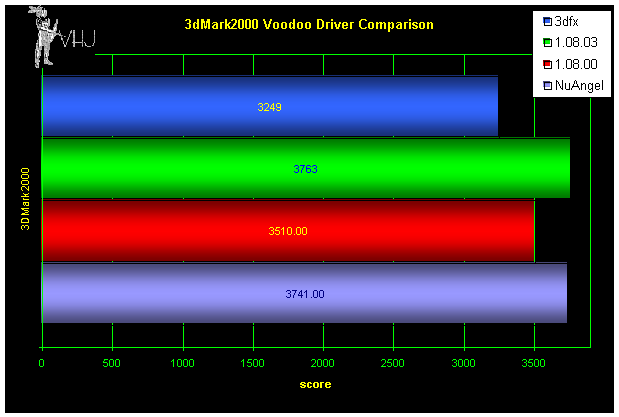
In 3DMark 2000 we see the 1.08.03 drivers edging out the NuAngel drivers by a hair. The 1.08.00 drivers are well behind the other two, while the 3dfx official drivers fall even farther back. The 1.08.03 drivers manage to improve on the last official 3dfx drivers by 16%! Let’s see if the same holds true in 3DMark 2001.
Test II: 3DMark 2001 (1024x768x32, Software T&L)

Here the scale is much more even with the NuAngel drivers leading by a hair and the 3dfx drivers close behind them. Both 3DMark 2K and 3DMark 2001 are synthetic tests, though—so lets move on to Quake 3 and 3dfx’s Glide/OpenGL performance.
Test III: Quake 3 (640x480x16, All Details Low)
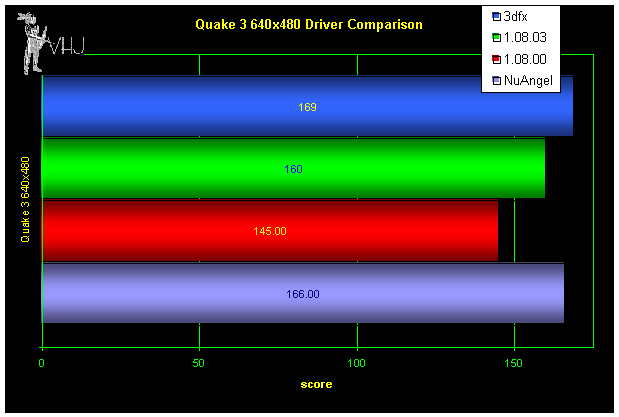
Here we again see NuAngel and 3dfx official battling for best performance while 1.08.03 falls just behind them and 1.08.00 brings up the rear. The 1.08.00 set, in fact, delivers chronically poor performance throughout the entire benchmark suite. Still at 640x480 we are testing the CPU more than the video card, so lets up the detail and see what happens.
Test IV: Quake 3 (800x600x32, HQ)

Once we start to turn up the detail things get more interesting. We see NuAngel and 3dfx still in a dead heat, but the 1.08.03 drivers leap ahead and decisively take the lead. Obviously these drivers are optimized more for high-end performance.
Test V: Quake 3 (1024x768x32, All Detail Maxed)
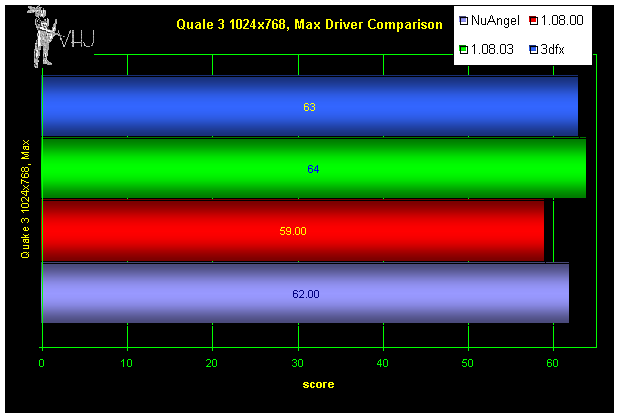
The 1.08.03 drivers continue to lead here with a 2 fps gain over NuAngel and a small but consistent 1 fps gain over the 3dfx Official drivers. Having looked at Quake 3, lets move on to our official D3D benchmark—Max Payne.
Test VI: Max Payne (1024x768x16, All Detail Maxed, Software T&L)
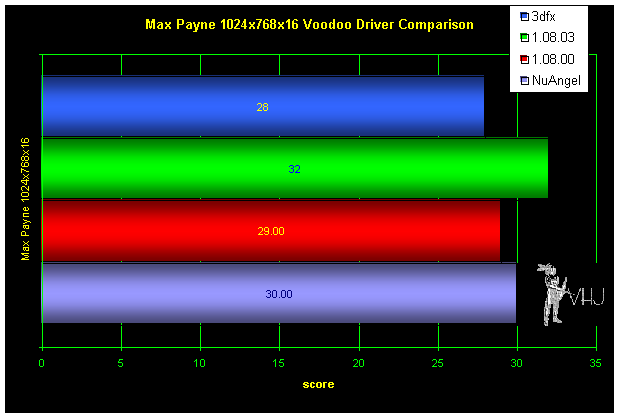
In D3D we see the 1.08.03 drivers again leading the pack with NuAngel right behind them and the 1.08.00 drivers behind them. The 3dfx drivers continue to bring up the rear. Let’s see what happens when we switch to 32 bit color.
TEST VII: Max Payne (1024x768x32, All Detail Maxed, Software T&L)
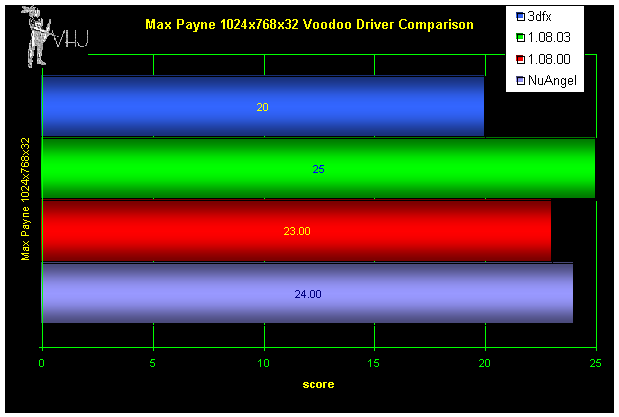
Not much changes in 32-bit color. The 1.08.03 drivers perform 20% faster than the 3dfx Official ones—once again, quite an achievement for a community-produced driver.
TEST VIII: Unreal Tournament (1024x768x16, High Detail)

All the driver sets performed nearly identically in UT (save for the 1.08.00’s) but 1.08.03 had a corrupted environment below 1024x768x16.
===================================
Notes On Driver Sets, Part I Conclusion
Unfortunately, benchmarks alone don’t tell the whole story about these driver sets. Here’s a few things you should know:
Non-Functional Feature Sets:
Many of the drivers contain new features inside the 3dfx tools section, but most of these do not work at all, or will crash games when enabled. Features like Z-culling do not work within Q3A, while HSR still causes visual corruption.
Drivers can be a bit flaky:
The 1.08.03 drivers are the fastest overall, but they have also been complained about as being slightly flaky. Unreal Tournament refused to run in these drivers below 1024x768 (although it was rock-stable at that resolution.
Driver Recommendations (Performance):
1.08.03
NuAngel 2.0
3dfx Official
1.08.00
Driver Recommendations (Performance and Stability):
NuAngel 2.0
1.08.03
3dfx Official
1.08.00
The 1.08.00 drivers are stable—but given that the 3dfx Official drivers are just as stable, I put the 3dfx Official drivers on top for their improved performance.
For performance AND stability the NuAngel 2.0 drivers win our recommendation.
===================================
Part II: Scaling the Voodoo5
One of the claim many 3dfx community members make is that the V5 scales far better as CPU power increases than the GeForce2 line of cards does. I was curious to see whether this was true, so I compared the testbed from Part I with a Duron 700 CPU running in the same motherboard.
A jump this massive should definitely show results—the AthlonXP 1800+ is over twice as fast as the Duron 700 and mounted on a 266 Mhz FSB (compared to 200 for the Duron).
For comparison we used a GeForce2 MX video card. Both tests were run using the 1.08.03 driver sets.
We examined the same four tests we looked at in Part I, and the results were dramatic. Games on the Voodoo5 ran, on average, 76% faster when matched with the AthlonXP 1800+ then with the Duron 700. The game that showed the greatest benefit from moving to the AthlonXP was Max Payne, with a 106% performance increase, while 3DMark2000 improved the least.
The GeForce2 outperformed the Voodoo5 on the Duron 700 by a wide margin. Its 3DMark 2000 and 2001 scores were approximately 15% higher and its Quake 3 scores were higher by an even margin of 10% across all resolutions and detail levels. The GeForce2 MX scales much worse than the Voodoo5, coming in with only a 20% gain. Keep in mind that the AthlonXP 1800+ is running at 220% the speed of the Duron 700. (7 * 2.2)=1.53 Ghz.
===================================
Excellent Scaling: But Two Important Caveats
While the V5 scales far more powerfully then the GF2 MX, there are two important caveats to remember.
1) Even though it scales well, the V5 is still outperformed by more powerful GF2 cards. Check our Kyro II review, available here. This review used an Athlon 1200 on an SDR motherboard, yet its still possible to see the GeForce2 Pro outperforming the V5 in Quake 3. The GF2 Pro turned in a score of 123, while the V5 on our DDR board and AthlonXP 1800+ turned in a score of 111. Even given the lower-scalability of GeForce2 cards, we could expect the GF2 Pro to pick up an additional 10-15% if mounted on our newer testbed—and thereby besting the V5 by over 25 fps. Unfortunately the card was not available for this review.
2) The Voodooo5 is approaching the limit of its scalability in 32-bit color. The best way to see this is to consult the following graph.
Quake 3 Arena Duron 700 scores vs. Athlon XP 1800+
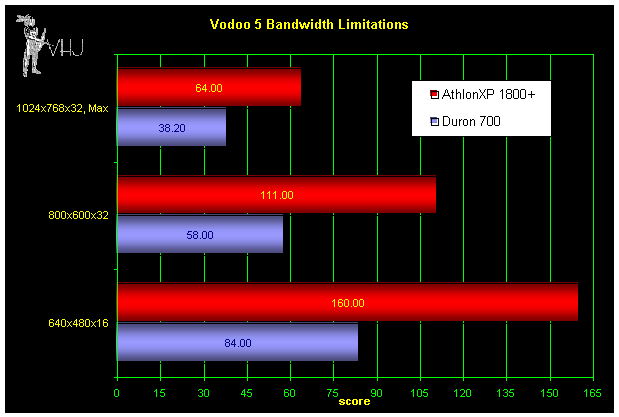
The results are clear. In 640x480 and 800x600 we see the AthlonXP 1800+ maintain a consistent 90% speed increase over the Duron 700. In 1024x768x32 however the picture changes dramatically and the AthlonXP commands only a 68% speed boost over the Duron 700.
The reason for this is simple. At 1024x768x32, all detail maxed, the Voodoo5 is reaching the limits of its memory bandwidth. From this point forward, higher CPU speeds will matter less and less as the card is not capable of moving texture data fast enough.
Certainly 1024x768x32 with maximum detail is a very nice setting—and 60 fps IS a perfectly playable frame rate. Furthermore, lowering detail levels or lowering color depth to 16-bit would allow the V5 to pick up quite a large speed boost. However, the fact remains, the card is effectively out of headroom. Had we run this test at 1600x1200x32, its doubtful that moving from a Duron 700 to an AthlonXP 1800+ would’ve yielded much improvement at all.
As games become ever more complex and texture data continues to grow, the Voodoo5 will inevitably fall by the wayside. It simply has too little memory bandwidth to continue to scale effectively. Still, for today, it remains a powerful competitor—and benefits substantially from a CPU upgrade.
===================================
Part III: The WindowsXP Question
The contents of this section changed, literally, overnight. I was going to write about how, despite their best efforts, the community had not yet managed to release a driver that ran games like Quake 3 without corruption in Windows XP.
However, that has now changed. Hujer HOE, a member of the x3dfx bulletin board, has posted functional WindowsXP drivers for the Voodoo3, 4, and 5. You should be aware that these are early beta drivers only. Some users have reported problems installing them and on my own system my Voodoo5 functioned as if it was a Voodoo4—only one of my VSA-100 chips was functional.
Nevertheless, these are the first drivers I have seen run Quake 3 without any visual artifacts or using a D3D wrapper. This is an astounding achievement and the drivers can be downloaded here.
For those of you who don’t wish to use such early drivers, there is still hope. Unknown to most, there was one other company that made cards using 3dfx technology—Powercolor. The company has announced that it DOES intend to support its “EVIL KING” video cards (based on the Voodoo4) with WindowsXP drivers, and any such drivers WILL be compatible with 3dfx cards as well. There IS light at the end of the tunnel.
===================================
Future Driver Developments and Source Code
So, where do driver developments go from here? I spoke to NuAngel (a major developer of the x3dfx Community drivers) to get some information. He confirmed to me that there are still plenty of upcoming community driver releases for the Voodoo cards—and hinted that there might still be a few performance enhancing tricks in the bag for the Voodoo4/5.
Still, what is desperately needed by the 3dfx Community is the one commodity no one seems to be able to produce: The 3dfx driver source code. NVIDIA claims not to own it, and no one from 3dfx has deigned to comment on its availability. If any official employees of these companies care to comment on this situation and the liklihood of further 3dfx drivers, please contact me.
The community has been quite excited by the unofficial WindowsXP drivers above and by PowerColor’s promise to release new drivers for the Evil King. There’s little doubt we’ll be seeing driver sets for a long time to come.
===================================
A Rather Shameful Situation: Who’s To Blame?
On the one hand, the 3dfx Community deserves to be congratulated for their tenacity and ingenuity. They’ve designed some performance-enhancing drivers even without source code and have managed to enable OpenGL and Glide on WindowsXP—a feat thought by many to be impossible. Simultaneously, however, the utter lack of NVIDIA to pick up 3dfx support is not a positive reflection on the company.
NVIDIA has unfortunately failed to capitalize on the business opportunity in front of them. The 3dfx community rightly or wrongly sees NVIDIA as responsible for 3dfx support—and while this is not legally true, (NVIDIA purchased only the core assets of 3dfx, not the company’s technical support responsibility) it nevertheless would’ve been a smart move of them to offer support—replacing dead Voodoo cards with GeForce equivalents (perhaps a GeForce2 MX for a V3, GeForce2 GTS for a V5) or something similar. Likewise, releasing drivers for the now-defunct Voodoo cards would’ve earned them a great deal of goodwill from 3dfx users. It still could, in fact, should NVIDIA choose to do so.
Unfortunately, this has not happened—and thousands of loyal 3dfx fans have been left without support or help for their products—their only crime being to support a company who pioneered the 3D acceleration industry. While this situation is not anyone’s “fault” in a legal sense, it is regrettable that no company stepped forward to support these products—particularly in light of the fact that doing so would’ve earned that company the gaming dollars of the 3dfx community. Many members have publicly said they would support whatever company gave them driver and technical support.
===================================
Conclusion
Even with 3dfx dead and gone, the user community they left behind is doggedly determined to continue on. Driver updates may squeeze another 10-15% performance out of the card, especially if source code is ever released, while most 3dfx cards can also handle a 10% overclock with little trouble. We will not cover overclocking the card in this article, but information on it can be found at the forums in the links below.
Perhaps the most fitting tribute to Scott Sellers and the other 3dfx employees and founders is the loyalty and strength of the user community they left behind. While it is doubtful that we will ever see a re-risen 3dfx, hopefully ATI and NVIDIA will take a lesson from the loyalty that 3dfx inspired—and respond accordingly. Offering support to these users now could mean huge dividends later.
===================================
Community Links
Here are a few links to popular 3dfx Community Sites:
The X3dfx Forum: http://pub43.ezboard.com/bx3dfx
3Dfx Lives On: www.3dfxliveson.com
Special thanks to NuAngel and CAirey (from the X3dfx Forum) for their help in writing this report.
===================================
Pssst! Our Shopping Page has been updated.
===================================